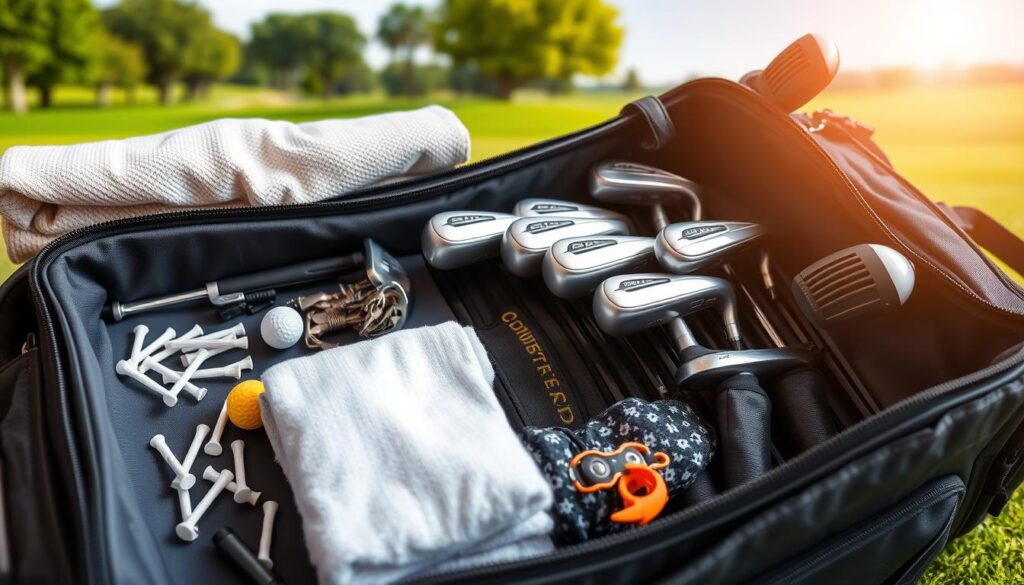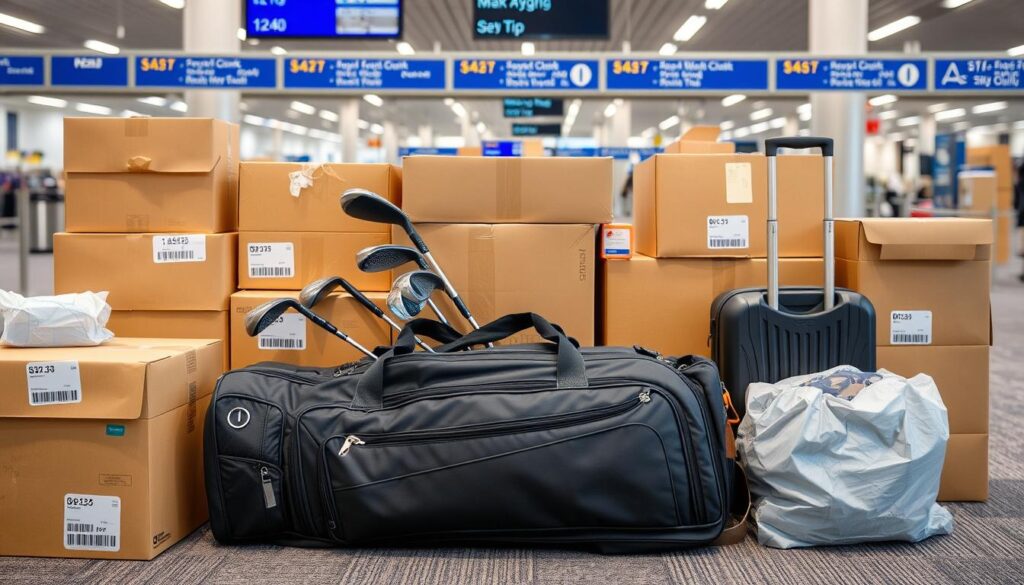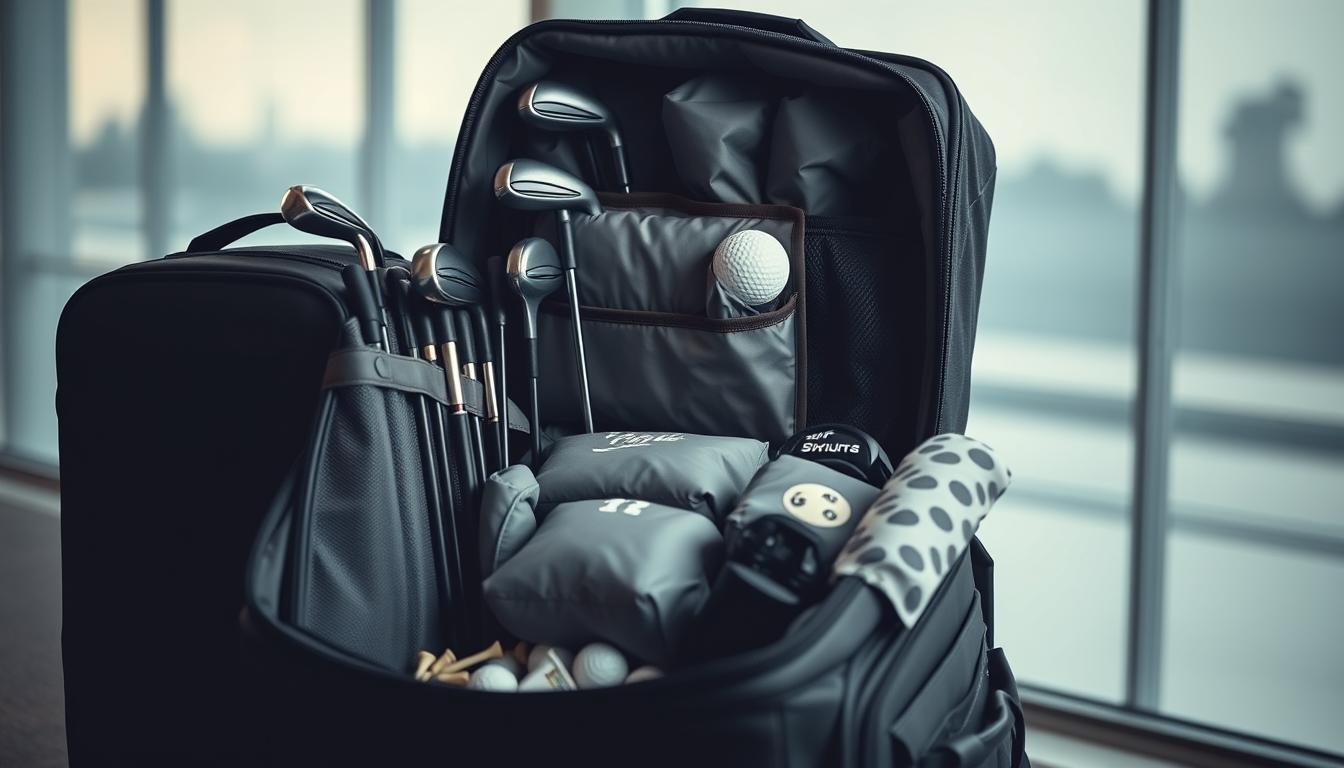Golf lovers enjoy playing on new courses. But, taking golf clubs on trips can be hard. This guide will show you how to pack them easily.
It covers picking the best travel bag and how to pack them for travel. We’ll talk about different ways to carry your clubs and tips for trips near and far.
Our goal is to keep your clubs safe and let you enjoy golfing without stress.
Key Takeaways
- Choose a sturdy travel bag for your golf clubs
- Use protective gear like head covers and stiff arm protectors
- Check airline policies before flying with golf clubs
- Consider professional shipping services for long-distance trips
- Insure your golf clubs for peace of mind during travel
Essential Equipment for Transporting Golf Clubs
Traveling with your golf clubs needs the right stuff. This ensures they get to your destination safely. Let’s look at the key items for a stress-free golf trip.
Hard-Shell Travel Cases vs. Soft Travel Bags
Golf club travel cases are hard or soft. Hard cases protect well but are big. They’re best for flying.
Soft bags are light and easy to carry. They’re perfect for driving but not as safe in the air.
| Hard-Shell Cases | Soft Travel Bags |
|---|---|
| Maximum protection | Lightweight |
| Bulky | Flexible |
| Ideal for air travel | Best for car trips |
Must-Have Protective Accessories
Get a stiff arm protector for your clubs. It’s a rod that goes up with your clubs. It helps protect them from bumps.
Use bubble wrap or foam for extra safety. It cushions your club heads.
Club Head Covers and Dividers
Club head covers prevent scratches. They’re a must-have. Full-length dividers in your bag keep clubs apart. This stops them from hitting each other.
Choosing the right bags and using protective gear keeps your clubs safe. They’ll be ready to play when you get to the course.
How to Travel with Golf Clubs: Step-by-Step Guide
Packing golf clubs for travel needs careful planning. This guide will help you keep your clubs safe during travel. It ensures they arrive safely at your destination.

First, clean your clubs well. Remove dirt and grass from the clubheads and shafts. This stops debris from scratching your clubs during travel.
Then, cover each clubhead with its headcover. If you don’t have covers, use soft towels or clothes. This extra layer helps prevent damage.
- Place your woods at the top of the bag, with irons below
- Secure clubs with padding or bubble wrap
- Remove detachable club heads and pack separately
- Use a stiff arm device to absorb impact
- Fill empty spaces with soft items like towels or clothing
For extra security, use a hard-shell case. If using a soft bag, wrap a belt or strap around it. This stops it from bending.
| Item | Purpose |
|---|---|
| Club covers | Protect club heads |
| Bubble wrap | Cushion clubs |
| Stiff arm | Absorb impact |
| Towels | Fill empty spaces |
Don’t forget to label your golf bag with your contact info. This helps if your clubs get lost during travel. By following these steps, you’ll greatly reduce damage risk to your golf equipment.
Understanding Airline Policies for Golf Equipment
Traveling with golf clubs? It’s key to know airline rules. Each airline has its own way of handling golf clubs. Let’s look at these rules to avoid surprises at the airport.
Major Airlines’ Golf Club Regulations
Most airlines see golf clubs as regular checked bags. Some let them count as part of your free luggage. Others might charge extra. Always check your airline’s policy before you fly.
Size and Weight Restrictions
Airlines have size and weight limits for golf bags. A standard golf bag usually fits, but big or heavy bags cost more. Pack smart to stay within limits:
- Maximum length: Usually 50-62 inches
- Maximum weight: Often 50 pounds
Additional Fees and Charges
Be ready for extra costs with golf clubs. Some airlines charge a flat fee for sports gear. Others might charge more based on where you’re going or if you’re a member. Here’s a quick look at possible fees:
| Airline | Domestic Fee | International Fee |
|---|---|---|
| American Airlines | $30-$150 | $150-$200 |
| Delta Air Lines | $30-$100 | $150-$200 |
| United Airlines | $35-$100 | $100-$200 |
Remember, these fees can change. Always check with your airline before booking. Knowing airline rules helps you plan and budget better.
Proper Packing Techniques for Maximum Protection
Packing golf clubs for travel needs careful steps. This ensures they reach their destination safely. The right methods protect your valuable gear during travel.
Securing Individual Clubs
First, cover each club head with its cover. Then, wrap towels or clothes around the shafts for extra cushioning. Next, group clubs together and use rubber bands or zip ties to keep them in place.
Using Stiff Arm Protectors
A stiff arm protector is key for club safety. It’s a rod that fits in your bag and extends above your longest club. It takes impact and keeps the bag from collapsing, protecting your clubs.
Organizing Clubs in the Travel Bag
Put clubs in the bag in a smart way. Place woods and drivers at the top. Then, put irons in the middle and wedges at the bottom. Use clothes or towels to fill empty spots. This keeps clubs safe and ready for your next game.
- Use head covers for all clubs
- Wrap shafts with towels or clothing
- Secure clubs with rubber bands or zip ties
- Install a stiff arm protector
- Arrange clubs strategically in the bag
- Fill empty spaces with soft items
TSA Guidelines and Security Requirements
When you fly with golf clubs, knowing TSA rules is key. The Transportation Security Administration lets you bring golf clubs in checked bags. But, they can’t go in carry-on bags. This rule keeps everyone safe and helps golfers.
Golf clubs get checked like other bags. TSA might look at your golf bag. So, make sure it’s packed well and tightly. Don’t forget, some items like golf GPS devices with lithium batteries must go in your carry-on.
- Pack clubs in a travel bag or hard case
- Remove loose items from pockets
- Secure all zippers and fasteners
Here are some tips to make security easier:
- Get to the airport early
- Tell TSA about your special gear
- Be ready to open your golf bag
Keep in mind, TSA rules for golf clubs can change. Always check the TSA website or talk to your airline before you go. Following these tips will help you travel smoothly with your golf clubs.
“Golf is deceptively simple and endlessly complicated.” – Arnold Palmer
Alternative Transportation Methods for Golf Clubs
Traveling with golf clubs doesn’t have to be hard. You can choose from many ways to get your clubs to your destination safely and easily.
Professional Shipping Services
Shipping golf clubs is a simple choice. FedEx and UPS have special services for golf gear. They pick up your clubs and deliver them to your hotel or golf course. This way, you don’t have to carry heavy bags and you can track your clubs.

Ground Transportation Options
Driving or taking the train makes it easy to carry your golf clubs. You can keep them safe in your car or in special spots on trains. This way, you have control over your clubs and it’s often cheaper than flying fees.
Golf Club Rental Services
Many places offer club rental services. This means you don’t have to bring your clubs. High-end courses have great rental sets for you to try. Renting clubs is good for those who don’t play often or want to travel light.
Every option has its good and bad sides. Think about cost, ease, and how you feel about new clubs. By looking at these choices, you can pick the best way to travel with your golf clubs.
Insurance Options for Golf Club Travel
Insurance is key when you travel with golf clubs. Golfers spend a lot on their gear. So, it’s important to keep it safe. Let’s look at the insurance choices you have.
Homeowners’ insurance might cover your golf clubs. But, it might have limits. Check your policy and think about extra riders for full protection. Travel insurance can help with lost or damaged clubs. But, make sure you read the details carefully.
There’s special insurance for golf equipment. It gives full protection for golfers. These policies cover theft, loss, and damage while you’re moving them. Some even cover you worldwide, great for trips abroad.
“Don’t let the fear of damaged clubs ruin your golf vacation. Proper insurance ensures you can focus on your game, not your gear.”
When picking insurance, think about deductibles, coverage limits, and how to make claims. Some policies give cash, others replace clubs. Pick what fits your needs and how often you travel.
| Insurance Type | Coverage | Pros | Cons |
|---|---|---|---|
| Homeowners’ | Limited | Already included | May have low limits |
| Travel | Moderate | Covers multiple items | Might exclude golf clubs |
| Specialized Golf | Comprehensive | Tailored for golfers | Additional cost |
The best insurance works with your efforts to keep golf clubs safe. Even with insurance, packing and handling well is still important.
Tips for Minimizing Damage During Transit
Keeping golf clubs safe while traveling is very important. You can use smart ways to protect them from getting damaged. Let’s look at some good methods to keep your clubs safe while moving.
Impact Protection Strategies
Wrap each club head in a soft towel or bubble wrap to protect it. Use foam tubing on club shafts for extra cushioning. Put clothes or towels between clubs to stop them from hitting each other.
A stiff arm extender in your travel bag can also help. It absorbs shocks and protects club heads.
Weather Protection Measures
Weather can change quickly, so be ready. Use a waterproof travel bag or cover to keep moisture out. Add silica gel packets inside to soak up any moisture that gets in.
For very hot or cold weather, use insulated covers for your clubs. These steps help keep your clubs safe from rain, snow, or extreme heat.
By following these tips, you’ll greatly reduce the risk of damage to your golf clubs while traveling. Remember, a little extra care goes a long way in preserving your equipment for many rounds to come.


